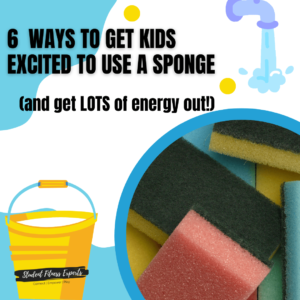More about using sponges
If you hand your kids a sponge, they might think that you’re asking them to clean something, which is definitely a great use of sponge, if your kids are willing, give them a bucket of soapy water and create a car or toy wash. Yet, a sponge can be so much more! When the temperatures rise, you need active and cooling experiences…check out all of our spongey ideas:

^ ways to get kids excited about using sponges
1. Sponge Bomb (improves catching, visual tracking, spatial awareness, and reaction time) You’ll need a sponge and a bucket of water.
(a) Solo play
- If you have one child, they can throw the sponge in the air and catch it, getting nice and wet in the process.
- Place targets on the ground, throw the sponge in the air, and try to hit the targets.
- Throw and run – throw the sponge in the air and see how far you can run before it hits the ground. Can also move in different ways, such as jumping, crawling, or skipping.
(b) Group game! Everyone, except one student, has a sponge “bomb”. The students holding the sponge bomb throw it into the air at the same time, and everyone tries to catch one. The one who doesn’t catch it has to do an action, such as 10 jumping jacks, 5 push-ups, or a short run. No one is out of the game!
2. Sponge Relay Race (improves dexterity, running, teamwork, and coordination)
Relay races are a fun way to add in a friendly competition to a day of play. You can start the game by having kids run and then up the challenge and have them jump, roll, spin, even crawl and put the sponge on their back to get from one bucket to the other.
- Separate the kids into two teams and each team lines up beside a bucket of water.
- The first child takes a sponge, soaks it in water, and runs to squeeze it in an empty plastic cup/bucket a few yards away. You can base the distance on the age of the children you’re playing with, the older the kids, the farther they can run.
- The child then runs back and hands the sponge to the next teammate in line who repeats the process.
- The first team to overflow their plastic cup wins.
- Solo play – If doing this with only 1 child, can make it a “minute to win it” challenge and see how far they can fill in a minute. Can also place the cups at various distances and create a points system. You can create fun prizes for the points such as choosing what’s for dinner or deciding where the next family adventure will be.
3. Sponge Splash (improves throwing, catching, visual acuity, and tactile awareness)
- This sponge toss game is always a hit and can be played with a large group or as few as two kids. Partners start close together and one teammate tosses a sponge soaked in water to the other. If they make 4 successful catches, the team takes 1 step farther apart and tosses again. If kids start missing more than 4 catches, they take one step closer to each other.
- Solo play – One child can try throwing and catching the sponge to themselves or you can have targets varied distances away and they can practice throwing through a hula hoop or into a bucket. Try using different-sized sponges to vary the challenge.
4. Under Over (improves body, spatial and directionality awareness as well as teamwork and coordination)
- To play this sponge pass game, each team lines up with a bucket of water at one end and an empty bucket at the other.
- The child at the front of the line picks up a soaking wet sponge and passes it over her head to the child behind her, who passes it under her legs to the next child.
- The children continue passing the sponge down the line, alternating over their heads and under their legs.
- The child at the end of the line squeezes the sponge into the empty bucket and then runs to the front of the line to begin the chain again.
- Once everyone has had a turn at the front of the line, the team with the most water in their bucket wins.
5. No hands (improves body awareness, coordination, balance, and strength)
- The object of this sponge pass game is to pass the sponge down the line, but don’t touch it with your hands!
- The teams can pass the sponge between their knees or lay down on their backs and pass it on their feet.
- If the sponge hits the ground, they must start over.
- The team who gets their sponge down the line the quickest is the winner.
- Solo play – Challenge your child in carrying the sponge from one bucket to the other without using their hands.
6. Sponge painting (improves throwing, strength, coordination and supports tactile engagement)
- Using various sized sponges or cutting up a couple of sponges, set up paper or cardboard along the wall, on the floor, or both. If you have been playing with us already this summer, you may already have your canvas from our noodle play. If not, check out last week’s post to create your own summer collaborative art masterpiece.
- Set up various containers of paint in bowls
- Dip the sponge into the paint and throw, drop, squish or roll the sponge onto your canvas.
- You can set up lines on the ground using painter’s tape or string so kids can see the difference in splatter pattern as well as the force required to throw the sponge from a farther distance.
